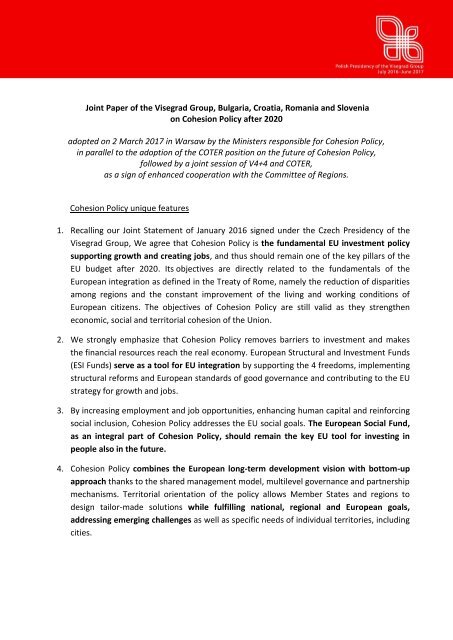V4_4_Joint_Paper_on_Cohesion_Policy_after_2020
V4_4_Joint_Paper_on_Cohesion_Policy_after_2020
V4_4_Joint_Paper_on_Cohesion_Policy_after_2020
You also want an ePaper? Increase the reach of your titles
YUMPU automatically turns print PDFs into web optimized ePapers that Google loves.
<str<strong>on</strong>g>Joint</str<strong>on</strong>g> <str<strong>on</strong>g>Paper</str<strong>on</strong>g> of the Visegrad Group, Bulgaria, Croatia, Romania and Slovenia<br />
<strong>on</strong> Cohesi<strong>on</strong> <strong>Policy</strong> <strong>after</strong> <strong>2020</strong><br />
adopted <strong>on</strong> 2 March 2017 in Warsaw by the Ministers resp<strong>on</strong>sible for Cohesi<strong>on</strong> <strong>Policy</strong>,<br />
in parallel to the adopti<strong>on</strong> of the COTER positi<strong>on</strong> <strong>on</strong> the future of Cohesi<strong>on</strong> <strong>Policy</strong>,<br />
followed by a joint sessi<strong>on</strong> of <str<strong>on</strong>g>V4</str<strong>on</strong>g>+4 and COTER,<br />
as a sign of enhanced cooperati<strong>on</strong> with the Committee of Regi<strong>on</strong>s.<br />
Cohesi<strong>on</strong> <strong>Policy</strong> unique features<br />
1. Recalling our <str<strong>on</strong>g>Joint</str<strong>on</strong>g> Statement of January 2016 signed under the Czech Presidency of the<br />
Visegrad Group, We agree that Cohesi<strong>on</strong> <strong>Policy</strong> is the fundamental EU investment policy<br />
supporting growth and creating jobs, and thus should remain <strong>on</strong>e of the key pillars of the<br />
EU budget <strong>after</strong> <strong>2020</strong>. Its objectives are directly related to the fundamentals of the<br />
European integrati<strong>on</strong> as defined in the Treaty of Rome, namely the reducti<strong>on</strong> of disparities<br />
am<strong>on</strong>g regi<strong>on</strong>s and the c<strong>on</strong>stant improvement of the living and working c<strong>on</strong>diti<strong>on</strong>s of<br />
European citizens. The objectives of Cohesi<strong>on</strong> <strong>Policy</strong> are still valid as they strengthen<br />
ec<strong>on</strong>omic, social and territorial cohesi<strong>on</strong> of the Uni<strong>on</strong>.<br />
2. We str<strong>on</strong>gly emphasize that Cohesi<strong>on</strong> <strong>Policy</strong> removes barriers to investment and makes<br />
the financial resources reach the real ec<strong>on</strong>omy. European Structural and Investment Funds<br />
(ESI Funds) serve as a tool for EU integrati<strong>on</strong> by supporting the 4 freedoms, implementing<br />
structural reforms and European standards of good governance and c<strong>on</strong>tributing to the EU<br />
strategy for growth and jobs.<br />
3. By increasing employment and job opportunities, enhancing human capital and reinforcing<br />
social inclusi<strong>on</strong>, Cohesi<strong>on</strong> <strong>Policy</strong> addresses the EU social goals. The European Social Fund,<br />
as an integral part of Cohesi<strong>on</strong> <strong>Policy</strong>, should remain the key EU tool for investing in<br />
people also in the future.<br />
4. Cohesi<strong>on</strong> <strong>Policy</strong> combines the European l<strong>on</strong>g-term development visi<strong>on</strong> with bottom-up<br />
approach thanks to the shared management model, multilevel governance and partnership<br />
mechanisms. Territorial orientati<strong>on</strong> of the policy allows Member States and regi<strong>on</strong>s to<br />
design tailor-made soluti<strong>on</strong>s while fulfilling nati<strong>on</strong>al, regi<strong>on</strong>al and European goals,<br />
addressing emerging challenges as well as specific needs of individual territories, including<br />
cities.
5. As indicated above, European Added Value of Cohesi<strong>on</strong> <strong>Policy</strong> can be seen in its all<br />
dimensi<strong>on</strong>s: ec<strong>on</strong>omic, social and territorial. It is also in such elements as: (a) an exchange<br />
of know-how and stimulati<strong>on</strong> of cooperati<strong>on</strong> across the EU, including through European<br />
Territorial Cooperati<strong>on</strong> and the macroregi<strong>on</strong>al strategies, (b) increasing efficiency and<br />
effectiveness of public spending i.e. through result-orientati<strong>on</strong>, or (c) building<br />
administrative capacity helping to focus <strong>on</strong> the strategic management in terms of better<br />
programming, implementati<strong>on</strong> and evaluati<strong>on</strong>.<br />
6. Cohesi<strong>on</strong> <strong>Policy</strong> strengthens the European project as it directly serves EU citizens and<br />
mobilizes them to communicate, cooperate and take up joint initiatives. Enhancing<br />
c<strong>on</strong>vergence between Member States and regi<strong>on</strong>s c<strong>on</strong>solidates Europe giving better<br />
perspectives for its citizens.<br />
Cohesi<strong>on</strong> <strong>Policy</strong> results<br />
7. Cohesi<strong>on</strong> <strong>Policy</strong> is the most extensively evaluated policy of the EU c<strong>on</strong>tributing to growth,<br />
employment and social inclusi<strong>on</strong> in various regi<strong>on</strong>s, including those in n<strong>on</strong>-cohesi<strong>on</strong><br />
countries. It is proved for example by Commissi<strong>on</strong> ex-post evaluati<strong>on</strong>s for years 2007-<br />
2013 or the evaluati<strong>on</strong> study <strong>on</strong> benefits for the EU-15 deriving from the implementati<strong>on</strong><br />
of Cohesi<strong>on</strong> <strong>Policy</strong> in the <str<strong>on</strong>g>V4</str<strong>on</strong>g> countries (available at: www.ewaluacja.gov.pl). The <str<strong>on</strong>g>V4</str<strong>on</strong>g> study<br />
inter alia shows that in the years 2007-2015 ec<strong>on</strong>omic benefits for the EU-15 resulting<br />
from Cohesi<strong>on</strong> <strong>Policy</strong> in <str<strong>on</strong>g>V4</str<strong>on</strong>g> amounted to 97 bn Euros (equivalent to 80% of the EU-15<br />
c<strong>on</strong>tributi<strong>on</strong> for the implementati<strong>on</strong> of Cohesi<strong>on</strong> <strong>Policy</strong> in those 4 countries). This<br />
evidence-based approach should be a corner st<strong>on</strong>e of streamlining the implementati<strong>on</strong><br />
procedures for the future while ensuring the right balance between stability of rules and<br />
their simplicity.<br />
8. We believe that adequate and effective communicati<strong>on</strong> of the results and socio-ec<strong>on</strong>omic<br />
impact of Cohesi<strong>on</strong> <strong>Policy</strong> in the Member States and their regi<strong>on</strong>s is necessary. It is in this<br />
spirit We have prepared a brochure <strong>on</strong> best practice projects in countries illustrating well<br />
the European Value Added of Cohesi<strong>on</strong> <strong>Policy</strong>.<br />
Cohesi<strong>on</strong> <strong>Policy</strong> bey<strong>on</strong>d <strong>2020</strong><br />
9. The l<strong>on</strong>g-term development support of Cohesi<strong>on</strong> <strong>Policy</strong> should remain stable and<br />
predictable as structural transformati<strong>on</strong> of regi<strong>on</strong>s, cities and other communities cannot<br />
be achieved in a short-term perspective.<br />
10. We believe that Cohesi<strong>on</strong> <strong>Policy</strong> should remain the policy for all EU regi<strong>on</strong>s with special<br />
attenti<strong>on</strong> to the less developed <strong>on</strong>es. Proper c<strong>on</strong>siderati<strong>on</strong> should be also given to the<br />
regi<strong>on</strong>s which may, due to spill-over and networking effects, have significant influence <strong>on</strong><br />
2
the development of the entire country. In this c<strong>on</strong>text there is an urgent need to clarify<br />
the l<strong>on</strong>g-term strategic framework and directi<strong>on</strong> in which the EU is to develop, especially<br />
as regards its growth and jobs agenda.<br />
11. In order to achieve cohesi<strong>on</strong> in development levels across EU regi<strong>on</strong>s and countries it is<br />
crucial to ensure transparent and coherent systems of programming and implementati<strong>on</strong><br />
sensibly linked to the European Semester process not <strong>on</strong>ly for Cohesi<strong>on</strong> <strong>Policy</strong> but also<br />
for other EU policies. Individual policies are not isolated silos – they should be c<strong>on</strong>sidered<br />
as a smartly-designed, forward-looking and balanced policy mix. Thus all efforts should be<br />
made to avoid negative competiti<strong>on</strong> between Cohesi<strong>on</strong> <strong>Policy</strong> and other EU instruments, in<br />
particular through exchange of good practices between all types of EU funds (both under<br />
the central and shared management model) and by providing similar implementati<strong>on</strong><br />
c<strong>on</strong>diti<strong>on</strong>s for the same types of projects.<br />
12. We believe that the future Cohesi<strong>on</strong> <strong>Policy</strong> should be based <strong>on</strong> a few important elements,<br />
including: result-orientati<strong>on</strong>, flexibility, proporti<strong>on</strong>ality, integrated approach and<br />
simplicity.<br />
13. To reinforce the result-orientati<strong>on</strong> of the Cohesi<strong>on</strong> <strong>Policy</strong>, We emphasize a need for:<br />
a. the shared management model ensuring a better ownership and resp<strong>on</strong>sibility for<br />
the policy implementati<strong>on</strong> am<strong>on</strong>g all stakeholders involved. There is a need to<br />
precise the roles and resp<strong>on</strong>sibilities of all stakeholders and establish a clear<br />
divisi<strong>on</strong> of their competences, with special emphasis <strong>on</strong> restoring trust between<br />
the Commissi<strong>on</strong>, other EU instituti<strong>on</strong>s and Member States. In this respect, it is<br />
crucial to find the right balance between the result orientati<strong>on</strong> of the policy and the<br />
level of checks and c<strong>on</strong>trols as well as simplificati<strong>on</strong> of procedures. This should also<br />
include the audit process, which should be based <strong>on</strong> trust, be preventive,<br />
predictable and proporti<strong>on</strong>al as well as respect the outcomes of the nati<strong>on</strong>al<br />
c<strong>on</strong>trol and audit authorities;<br />
b. fewer but well targeted, defined and communicated ex-ante c<strong>on</strong>diti<strong>on</strong>alities<br />
based <strong>on</strong> the key investment barriers most relevant for the growth and jobs agenda<br />
and with a clear system of assessing their fulfilment. We call for more c<strong>on</strong>sistency<br />
between ex-ante c<strong>on</strong>diti<strong>on</strong>alities and other measures linking the ESI Funds,<br />
including the relevant Country Specific Recommendati<strong>on</strong>s and avoiding a<br />
duplicati<strong>on</strong> with existing EU compliance regimes;<br />
c. thematic c<strong>on</strong>centrati<strong>on</strong> - ensuring the right balance between thematic support and<br />
specific needs of Member States, regi<strong>on</strong>s and cities;<br />
3
d. str<strong>on</strong>ger focus <strong>on</strong> using of off-the-shelf simplified cost opti<strong>on</strong>s which should be<br />
available from the beginning of implementati<strong>on</strong>.<br />
14. We emphasize there is a str<strong>on</strong>g need to create more flexibility for nati<strong>on</strong>al, regi<strong>on</strong>al and<br />
local authorities to address their specific objectives within the operati<strong>on</strong>al programmes,<br />
including the use of the integrated territorial approach.<br />
15. We support proporti<strong>on</strong>ality that would maintain high standards of investments supported<br />
by Cohesi<strong>on</strong> <strong>Policy</strong> in each Member State and regi<strong>on</strong>, while limiting administrative costs<br />
and allowing for a visible reducti<strong>on</strong> in administrative burden. The proporti<strong>on</strong>ality should<br />
not be limited <strong>on</strong>ly to the volume of allocati<strong>on</strong>, but other elements such as reliability of<br />
instituti<strong>on</strong>s, efficiency of management and c<strong>on</strong>trol systems or the error-rate level could be<br />
explored. It is very important, however, to ensure that proporti<strong>on</strong>ality does not lead to<br />
further complexity of programming or implementati<strong>on</strong>.<br />
16. With a view to supporting the European integrati<strong>on</strong> and the harm<strong>on</strong>ious development of<br />
the Uni<strong>on</strong>'s territory at various levels, We count <strong>on</strong> strengthening the Interreg<br />
programmes. They should be implemented in shared management, based <strong>on</strong> simplified<br />
rules and should be more result-oriented. Small scale projects should still play a vital role in<br />
the cooperati<strong>on</strong> across borders but funding should be also directed towards those strategic<br />
investments, which will have a potential to give a str<strong>on</strong>ger impetus to improving territorial<br />
cohesi<strong>on</strong> of border areas. Closer alignment of implementati<strong>on</strong> mechanisms of crossborder<br />
ENI and IPA programmes to Interreg is desirable.<br />
17. Moreover, We recognize the significance of financial instruments across all relevant policy<br />
areas and their enhanced complementarity with grants. The selecti<strong>on</strong> of a form and<br />
sources of financing should be appropriate for the goals, which are to be delivered. Making<br />
use of financial instruments should be much simpler and aligned with market practices.<br />
Effectiveness of financial instruments should be measured in terms of achieving public<br />
policy objectives, not just their financial multiplier.<br />
18. Drawing less<strong>on</strong>s from the delayed launch of the 2014-<strong>2020</strong> implementati<strong>on</strong>, We c<strong>on</strong>sider it<br />
very important to start the programming process for post <strong>2020</strong> period as so<strong>on</strong> as possible.<br />
The informal dialogue between the Commissi<strong>on</strong> and Member States about the basic<br />
c<strong>on</strong>diti<strong>on</strong>s for the new programming period should start prior the Commissi<strong>on</strong> submits<br />
legislative proposals. Following the previous experience and work of the High Level Group<br />
reflecting <strong>on</strong> future of Cohesi<strong>on</strong> <strong>Policy</strong> We call <strong>on</strong> the Commissi<strong>on</strong> to establish, by mid-<br />
2017 the latest, an informal platform with representatives of all Member States with a<br />
view of providing a basis for an early start of the post <strong>2020</strong> programming process.<br />
4





